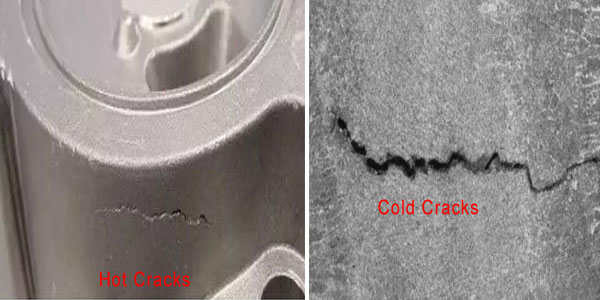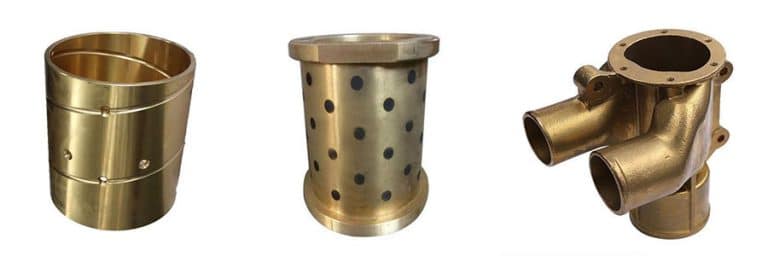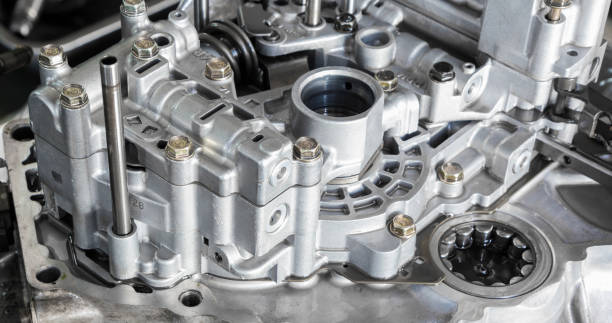The biggest defects of Investment Casting
Among all casting defects, The biggest defect of Investment Casting on product quality is casting cracks. According to its characteristics, it can be divided into hot cracks and cold cracks. The defects are not allowed to exist in production.

(1) Hot cracks
The hot cracks usually happened at the end of solidification or shortly after the end of solidification. The castings are still in the high-temperature stage. The strength and plasticity are very low. The formation temperature is between 1250 and 1450 ° C. It is caused by the solid shrinkage of the casting.
The main characteristics of hot cracks are:
- 1)Initiating in the grain boundary and expanding along the grain boundary. Th shape is not uniform in thickness and irregular in tortuosity;
- 2)Usually a cracked network;
- 3)The surface of the crack is oxidized and has no metallic luster. The crack surface of the steel casting is approximately black;
- 4)The crack ends are round and blunt, with significant oxidation and decarburization on both sides. Sometimes there are obvious defects such as looseness, inclusions, and holes.
According to the formation position of the hot cracks in the casting, it can be divided into an outer crack and an inner crack.
The hot crack that can be seen on the surface of the casting is an external crack. External cracks often occur at the corners of the casting. Where local solidification is slow and stress concentration is likely to occur.
It is characterized by a wide surface, a narrow core, and a tear-like shape. Sometimes the fracture penetrates through the entire casting section.
Internal cracks generally occur inside the casting and at the final solidification.
Its characteristics are irregular shapes. The crack surface is often accompanied by dendrites. Normally, internal cracks do not extend to the surface of the casting. A typical example of an internal crack is the crack revealed by the root after the riser is removed.
The reasons for the formation of hot cracks can be summarized as:
- 1)The shrinkage stress during casting cooling is too large;
- 2)The casting is blocked in the mold;
- 3)The casting is not uniformly cooled;
- 4)The structural design of the casting is unreasonable, and there is a sudden change in geometry;
- 5)Harmful impurities are enriched at the grain boundaries;
- 6)There is an interaction between the surface of the casting and the coating.
(2) Cold cracks
The cold crack is a process in which the casting is continuously cooled to room temperature after the solidification of the casting. And the tensile stress caused by the casting is greater than the breaking strength of the casting body.
The main features of cold cracking are:
- 1)It always occurs at the part that is subjected to tensile stress. In particular, stress concentration points where the shape and size of the casting change;
- 2)The crack width is uniform and slender, and it is straight or broken, and the crystal is expanded;
- 3)The crack surface is relatively clean, smooth, delicate, with metallic luster or mild oxidation color;
- 4)The crack tip is sharp, and there is almost no oxidation and decarburization on both sides of the crack. The microstructure is basically the same as that of the matrix.
The causes of cold cracks can be summarized as:
1)The design of the casting structural system is unreasonable.
The uneven wall thickness of the casting will result in casting stress and sometimes cold cracking. Castings of rigid structures, due to the obstruction of their structure, shrinkage stress caused by temperature reduction tends to cause cold cracking of the casting. Castings with thin-walled large cores and thin walls are very prone to cold cracks;
2)The design of the pouring riser system is unreasonable.
For castings with uneven wall thickness, if the inner gate is placed in the thick wall part of the casting. The cooling speed of the thick part of the casting will be slower, causing or aggravating the cooling rate of each part of the casting. The difference increases the thermal stress of the casting, it is easy to cause cold cracking in the casting.
If the position of the pouring riser is not properly designed. It will directly hinder the shrinkage of the casting and make the casting easy to produce cold cracks.
3)The strength of the sand or core is too high.
The high-temperature repellent is poor. Or the sand is too tight. The shrinkage of the casting is hindered, causing large tensile stress, resulting in cold cracking of the casting.
4)The chemical composition of the steel is unqualified.
The harmful elemental phosphorus content is too high. Increase the cold brittleness of steel and easily cause cold cracks
5)Castings are prematurely opened. The falling sand temperature is too high. Collision or extrusion during sand cleaning can cause cracking of the casting.
In the next article, we will discuss more Investment Casting Defects Analysis and Remedies. Keep in touch.


